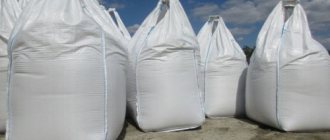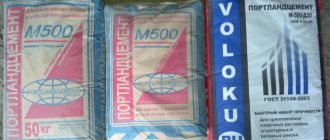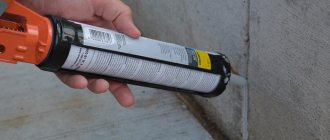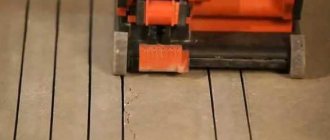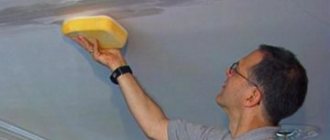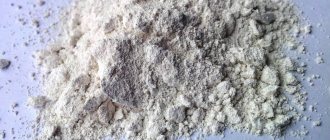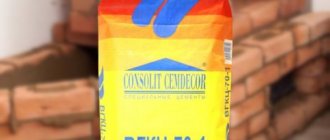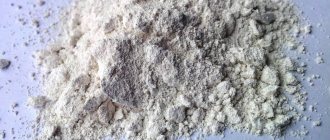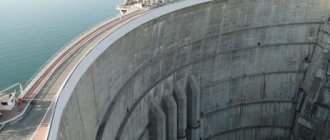Tensile cement belongs to the group of materials that undergo linear expansion in the range of 0.3-2%. It differs in properties depending on the composition, so it is used in special cases. The scope of its application is wide; such cement is in demand during the construction of objects that will be operated in difficult conditions.
NTs cement (tensioning, NTs 20) for waterproofing and sealing joints: what is it, characteristics
Tensile cement belongs to the group of materials that undergo linear expansion in the range of 0.3-2%. It differs in properties depending on the composition, so it is used in special cases. The scope of its application is wide; such cement is in demand during the construction of objects that will be operated in difficult conditions.
What it is
NC stands for tensile cement. It is distinguished from similar compositions (in particular, Portland cement), due to its excellent performance characteristics. Thus, material with the designation NTs is resistant to moisture and has the highest strength index. It is devoid of all the disadvantages that are inherent in cement subject to shrinkage.
As a result, the risk of cracks is eliminated, and at the same time the service life of the structure increases. NC cement is the most preferred option when creating stressed concrete products and structures for various purposes. This type of binder composition contains clinker grinding, alumina slag, and stone gypsum.
The first component is present in the largest quantity. This composition ensures strength. To increase the rate of hardening, lime is added.
Classic (shrinkage) cement undergoes shrinkage - 2 mm/m. This material gains strength within 3 weeks, and often longer than the specified period. Due to its properties, cracks form during the hardening process, which leads to a reduction in the service life of the structure.
Tensile cement, on the contrary, gains sufficient strength within a few days - 300 kg/cm². This is due to the linear expansion of the raw mixture. The high rate of hardening and increased strength of the material are due to the combination of the main components of non-shrinkage (tensioning) cement.
When working with such mixtures, you need to perform all manipulations quickly, since the material begins to gain strength almost immediately after pouring is completed. The duration of the setting period varies depending on the content of the main components.
Often the material begins to harden a few minutes after preparation, which does not allow eliminating all defects during the formation of the cement layer.
Characteristics and types
At this point in time, the following types of expanding cements are produced, the characteristics of which comply with the requirements of the current regulatory document - Expanding cement GOST 11052-74: waterproof expanding cement, gypsum-alumina cement, expanding Portland cement, prestressing cement and expanding slag Portland cement.
Let's look at each type of binder in more detail.
- Waterproof expansive cement. The production technology consists of grinding or mixing in a ball screen: aluminous cement, gypsum and calcium aluminate. This type of building material is characterized by rapid setting - beginning no earlier than the 4th minute, ending no later than the tenth minute. In some cases, it is necessary to increase the setting time by adding special additives. Scope of application: repair of concrete structures, waterproofing of underground structures, construction of underground tanks.
- Gypsum-alumina expanding cement. Produced by co-grinding or mixing: high alumina clinker (slag) and calcium sulfate dihydrate (gypsum). Setting of concrete or mortar begins no earlier than the 20th minute and ends no later than the 240th minute. Final hardening and strength gain occurs 70-85 hours after mixing. Applications of this type of expanding cement: non-shrinking waterproof concrete and mortar, waterproofing of underground structures, sealing joints.
- Expanding cement RPC 20. This building material is obtained by simultaneous grinding of ordinary Portland cement clinker, aluminous clinker (slag), calcium sulfate and blast furnace slag (replacement with another active additive is allowed). Concrete based on this type of expanding cement is characterized by rapid hardening during short-term steaming, high density and a high degree of water resistance. Setting of concrete occurs no earlier than half an hour after mixing and no later than 12 hours. Final hardening and strength gain - after 70-80 hours (with steaming after 30-35 hours). Scope of application: construction of hydraulic structures and concrete tanks.
- Tensile cement. It is made by mixing in certain proportions: Portland cement, aluminous cement and gypsum. It has the property of first hardening, gaining strength, and only then expanding in volume. In this case, the beginning of setting occurs no earlier than half an hour, and no later than 4 hours after mixing. Scope of application: repair of reinforced concrete structures, production of concrete pipes under pressure, construction of tanks, construction of sports facilities.
- Expanding Portland slag cement. The beginning of setting of the solution occurs no earlier than 30 minutes, the end of setting no later than 4 hours. Used for: sealing holes in concrete structures, installing anchor connections, sealing cable and pipe passages, sealing joints and seams, caulking sewer line entries.
Composition of the product
The material is produced in accordance with GOST 31108-2003 “General construction cements” and GOST R 56727-2015 “Prestressing cements”. Its composition includes the following components:
- Portland cement clinker. This is the main component for the preparation of NC cement. Its share in the total composition is at least 67%, it gives the material resistance to cracking.
- Aluminous slag and special expansion additives. The total percentage of these substances is 6-20%.
- Mineral components based on calcium sulfate, for example, gypsum (up to 10%) and auxiliary substances (blast furnace slag and others).
Alumina slag
According to GOST, NC cement may also contain other substances. The main thing is that they do not reduce the service life of the material and do not cause corrosion of the reinforcement used in the construction of buildings.
Peculiarities
A monolith based on prestressing cement increases its volume already on the third day after pouring. At the same time, it sets faster than classical compounds, without sacrificing strength.
The coagulation hardening binders used in the material guarantee a high level of adhesion. Therefore, when performing repair work, when the screed is applied to the old base, it is necessary to clean its surface in order to obtain a solid monolith.
One of the features of this cement is the prohibition on mixing with other types of binders, including ordinary Portland cement. This will change its technical characteristics, which will lead to a decrease in expansion properties, impair water and gas permeability, and fire resistance.
Manufacturers
- Pashiysky metallurgical and cement plant. Produces GGRC with the addition of gypsum stone and blast furnace slag in accordance with GOST 11052-74. The product is produced in paper bags weighing 45 kg, and is shipped in MKR-1, OS containers to all regions of the Russian Federation. The company also cooperates with neighboring markets, mainly CIS countries.
- Mapei. An Italian company known throughout the world for the production of construction chemicals, including cements that can increase in volume. The range includes waterproof non-shrinking mixtures, polymer compounds, even materials for underwater work. At retail, the material is sold in bags weighing 20 kg.
- Macflow. New generation rheoplastic cement from the Russian company AtacamaST. Used to produce cast concrete mixtures, filling cracks and voids in stone and concrete structures. The material is packed in 25 kg bags.
- Roussean. Russian manufacturer of building mixtures, including prestressing cement and GGRC. The compositions are suitable for the manufacture of waterproofing plaster and waterproof concrete, as well as for the construction of structures for storing petroleum products.
Advantages and disadvantages
In addition to the beneficial characteristics of the composition described above, it is also worth highlighting additional advantages. NC:
- differs in fire resistance and explosion safety;
- allows you to increase the durability of the structure by 3-6 times;
- does not form toxic compounds;
- expands immediately throughout the entire volume, due to which a minimum number of voids is formed, and the concrete itself is evenly distributed over the poured plane.
If we talk about the disadvantages of this mixture, it is worth noting that NC may lose some of its properties under very frequent temperature loads exceeding 35 degrees. It is also worth considering that self-expanding mixtures are often counterfeited, so it is recommended to purchase this product only after the seller has provided a certificate for the product. The cost of cement is about 150 rubles for 20 kg of NC 10 and about 170-300 rubles will have to be paid for the same package of NC 20.
Expanding cement nts 40
Ordinary Portland cement, which is part of concrete, is characterized by low water resistance and resistance to frost and aggressive environments.
To solve this problem, a special group of compounds called self-expanding or non-shrinking cements was developed.
The most prominent representative of this group is tensile cement (SC), which best meets all operational requirements and is suitable for installation in difficult conditions.
A distinctive feature of this composition is that cement of this type begins to increase in volume during the process of hardening of the concrete mass. Thanks to this, shrinkage and frost do not have a detrimental effect on the constructed structure.
Tensile cement NTs and its use for the production of prestressed concrete
| Tension cement is a hydraulically expansive, fast-setting, fast-hardening cementitious substance widely used for waterproofing as hydraulic cement. NC tensile cement is produced by mixing and grinding a mixture of Portland cement, gypsum, aluminate and sulfoaluminate materials (alumina cements). NTs prestressing cements are intended for producing self-tensioning reinforced concrete and hydraulic concrete. Hardening of prestressed hydraulic concrete can take place at normal temperature or under heat treatment conditions. | Price | Payment | Stock | |
| NTs-10 - non-shrinkable | 25 kg | 370 rub. | b.cash | m. Ryazansky Prospekt |
| NTs-10 - non-shrinkable | 40 kg | 540 rub. | b.cash | Podolsk |
| NTs-20 - straining | 20 kg | 250 rub. | cash/bank cash | Chelyuskintsev village |
| NTs-20 - straining | 25 kg | 370 rub. | b.cash | m. Ryazansky Prospekt |
| NTs-20 - straining | 40 kg | 540 rub. | b.cash | Podolsk |
| NTs-40 - expanding | 25 kg | 370 rub. | b.cash | m. Ryazansky Prospekt |
| NTs-40 - expanding | 40 kg | 540 rub. | b.cash | Podolsk |
Varieties and composition
Tensile cement is a self-expanding material used in construction. It is distinguished by its waterproofness and durability. Includes:
- finely ground Portland cement clinker – 70%;
- alumina slag – 20%;
- gypsum – 10%.
Depending on specific requests, the composition may vary slightly, but it should not be mixed with other binders. To increase resistance to deformation, lime is added. Tensile cement is marked depending on the degree of expansion during setting:
- non-shrinking composition – NTs 10;
- average expansion rates - NC 20;
- high expansion – NC 60.
The most common brand of prestressing cement is NTs 20. When setting, this material expands to 1.5% of the initial volume, as a result of which it acquires additional strength. Concrete structures with such a binder component can withstand water pressure of 20 atmospheres, and gas tightness improves 40 times compared to classic concrete. Therefore, it is used for the construction of swimming pools, also in deep-water structures.
Characteristics and properties
The characteristics of prestressing cement are regulated by GOST 31108-2003, which reflects the ratio of the components included in this material. This allows you to obtain accurate data necessary for calculating the future building, structure or structure.
One of the properties indicated on the packaging is the initial setting time of the composition. Under standard conditions it is 0.5 hours. The bending strength after 2 days is 3.8 MPa, and after 4 weeks it is already 5.9 MPa. The compressive strength in the same time frame is 14 and 49 MPa, respectively. This is more than for conventional concrete with Portland cement as a binder.
An important indicator is the self-stress of such concrete (about 2 MPa). This allows you to create prestressed reinforced concrete structures with high pressure on the reinforcement. This property allows the construction of high-strength foundations and vertical monolithic structures.
The minimum frost resistance of the material corresponds to F30. For concrete based on NTs 20 tensile cement, this figure can reach 1500 freezing and thawing cycles. No other composition can withstand such loads. It is also explosion-proof and fire-resistant.
- -waterproof capacitive structures - swimming pools, settling tanks, tanks
- for water, gas, oil products;
- -waterproofing coatings for floors, bridges, roofs;
- -transport and communication tunnels, including metro;
- -individual low-rise construction - underground garages, basements, bathhouses,
- loggias, etc.
- -crack-resistant waterproof seams, joints of all types;
- -repair, reconstruction, strengthening of structures, restoration of water resistance.
For the installation of waterproofing coatings: the surface on which the coating is applied must be durable, without delamination, without greasy stains and dirt. The surface of the fittings should also be free of grease. Before applying the coating, the surface must be moistened. Depending on the requirements for the structure, the waterproofing coating can be made of mortar or concrete. It is not allowed to work under water pressure! To obtain a waterproof cement-sand mortar, it is necessary to mix NC with clean sand in a ratio of 1:2 and mix it with the required amount of water (40% by weight of cement). Apply the solution by torquetting or pneumatic spraying. It is allowed to apply the solution manually as long as the necessary compaction of the mixture is ensured. Concrete is prepared using conventional technology using NC cement instead of Portland cement. The consumption of NC is 450-500 kg per 1 m³ of concrete. The concrete mixture must be thoroughly mixed and thoroughly compacted when laying. The next day after production, the surface of the structure must be moistened. Keep the surface of the structure moist and protect it from drying out for 7 days. Mixing NC cement with other types of cement is not allowed, as it will lose its special properties. The consumption of dry mixture per 1 m² of surface with a layer thickness of 10 mm is 18 kg (NC cement consumption is 20 kg). Shelf life: no more than 6 months in a dry place.
Specifications
Expanding (tensioning) cement is highly durable. When choosing a type of material with such characteristics, the intended purpose of the concrete structure is determined, which makes it possible to determine sufficient indicators of moisture absorption and porosity. Based on these parameters, the type of composition is selected.
Tensile cement belongs to concrete class B40. At the same time, it is characterized by minimal moisture absorption and porosity compared to Portland cement and compositions containing plasticizers.
Brands and properties
There are:
- NTs-10;
- NTs-20;
- NTs-40.
The first option is a non-shrink mixture. The main characteristic of such a material is minimal linear expansion. The NTs-20 brand is in greater demand than others, which is due to its average characteristics: sufficient strength, moderate increase in volume upon hardening.
Tensile cement NTs-20 belongs to the middle price category, which contributes to its wide distribution. This material can be used on various objects.
For comparison, the latter option is more durable. In other indicators it also surpasses the previously discussed analogues. Such material can expand significantly. It is used in facilities with increased requirements for materials in terms of strength, moisture resistance and linear expansion.
The service life of the finished structure increases many times over. However, during the work you need to be careful, because NTs-40 cement sets quickly. The material is more expensive than analogues.
Properties of compositions marked NC:
- increased resistance to compressive loads;
- the mixture hardens 30 minutes after pouring;
- the finished structure made of NC material is characterized by a minimal number of pores, which ensures waterproofing properties;
- abrasion resistance;
- airtightness;
- After hardening, the cement mixture can withstand up to 1500 freezing/thawing cycles, while the structure does not collapse and the structure does not change;
- the material is resistant to aggressive environments;
- a high rate of adhesion of the cement mixture layer to surfaces made of various materials is ensured;
- Linear voltage: 0.3-2%;
- self-stress - from 2 MPa;
- operating temperature range: +5…+35°С.
Advantages and disadvantages
Positive traits:
- unlimited period of operation;
- the material does not contain harmful additives;
- versatility: NC cement is used for waterproofing, sealing joints, during the construction of foundations, swimming pools and other objects;
- excellent performance characteristics.
CN cement has few disadvantages. They note the high price. Moreover, the cost in Moscow and the regions is different. In addition, fakes are often found on sale. If there is no experience and knowledge, quality material can only be determined if the seller has a quality certificate. Also, not all brands of NC cement can withstand low temperatures.
Peculiarities
If the composition of the mixture is adjusted, you need to remember that if the proportions are greatly violated or strengthening additives are added, the setting speed increases. It will be difficult to work with such cement.
When the dry mixture runs out at the final stage of work, you cannot add components to increase the volume of the material, as this may cause a decrease in strength, fire resistance and loss of other properties.
Scope of use
Cement can be used as:
- Hydraulic seals – providing reliable elimination of local leaks.
- Coating layer - for effective protection of structures from moisture, including during prolonged contact.
The material is widely used in the repair and construction process for waterproofing:
- Foundations, plinths, basements, garages, balconies, loggias.
- Concrete floors in the bathroom, shower, bath, sauna.
- Various tanks designed for storing water (including swimming pools), oil and gas products.
- Surfaces of supports of bridges, tunnels, subways, roofs, etc.
Due to its elasticity, NC Rusean cement is ideal for sealing joints and seams that are exposed to moisture. Depending on the location of application and the size of the surface to be treated, the solution can be applied with a conventional spatula, shotcrete, or pneumatic spray.
At Skladom.ru you can buy NC cement at a low cost in any quantity, from one bag to a large batch.
Scope of application
The concept of self-stressed concrete, for the production of which tensile cement is used, is based on the absence of shrinkage during its laying. Preserving the shape of the monolith after pouring makes this composition ideal for constructing foundations and screeding floors, creating structures, buildings and structures.
The water resistance of concrete with NC allows its use in the construction of swimming pools, drains, and sewer channels. High-strength sand concrete and waterproofing mixtures based on prestressing components are used in the construction of wastewater treatment facilities and structures periodically exposed to water or aggressive environments.
The increased strength of structures made of self-stressed concrete determines their use under high static and dynamic loads, in pipelines, and in areas with difficult terrain and climate. It is used for casting vertical elements of buildings, manufacturing multi-hull type floor slabs, storage facilities, including for toxic waste. Tensile cement and mortars based on it are used to perform the following work:
- repair and strengthening of the foundations of buildings and structures, especially in areas with high groundwater levels;
- construction of reservoirs for water, oil products, and other chemically active substances;
- creating waterproofing barriers;
- repair of chips, cracks, seams of vertical and horizontal surfaces;
- construction of stoves, fireplaces, boiler rooms;
- installation of drains, running tracks, runways, sections of highways subject to high loads;
- used to produce composite materials;
- low-rise construction, concreting basements, underground communications.
RUSEAN NC mixture (based on prestressing cement) 25 kg
| Color | grey |
| Application area | walls and floors |
| Maximum fraction, mm | 2,5 |
| Mixture consumption per 1 m² with a thickness of 10 mm, kg | 18 — 19 |
| Water consumption per 1 kg of dry mixture, l | 0,07 — 0,15 |
| Mobility of the mortar mixture, | PC3 |
| Bulk density, mixtures, kg/m³ | 1480 — 1520 |
| Density of the solution, kg/m³ | 1900 — 1950 |
| Layer thickness, mm | 10 — 30 |
| Adhesion to concrete, after 28 days, MPa | 0,5 |
| Work temperature | from +5°C to +25°C |
| Viability of solution, hour | 1 |
| Operating temperature range | -35°C to +40°C |
| Frost resistance | F50 |
| Waterproof | W10 |
| Compressive strength, MPa | 17,1 |
| Expiration date, months | 6 |
| Bag weight, kg | 25 |
Areas of use
- waterproofing of floors and roofs;
- waterproofing of various communication tunnels;
- waterproofing garages and basements;
- restoring the integrity of structures.
Preparation of the solution
To prepare a waterproof solution, it is necessary to mix the dry NC mixture with water in a proportion of 0.07-0.15 l per 1 kg of dry mixture.
Features of use
The prepared solution is applied to the surface by pneumatic spraying or torquetting. The work is carried out in several stages until the required coating thickness is obtained. If necessary, the waterproofing solution can be applied manually. The next day after production, the surface of the structure must be moistened. Keep the surface of the structure moist and protect it from drying out for 7 days. It is possible to use any additives (plasticizing, antifreeze, air-entraining, complex, etc.).
The consumption of the working mixture with a layer of 10 mm is 18-19 kg per square meter.
